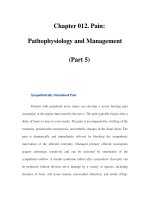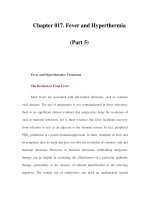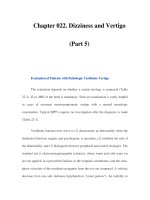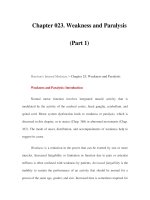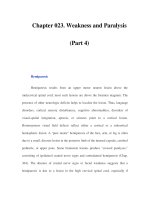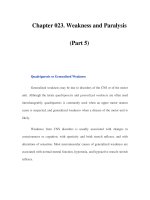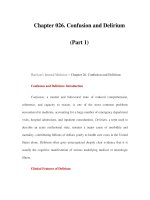Chapter 026. Confusion and Delirium (Part 5) pps
Bạn đang xem bản rút gọn của tài liệu. Xem và tải ngay bản đầy đủ của tài liệu tại đây (60.04 KB, 4 trang )
Chapter 026. Confusion and Delirium
(Part 5)
Abbreviations: LSD, lysergic acid diethylamide; GHB, γ-hydroxybutyrate;
PCP, phencyclidine; CNS, central nervous systemPrescribed, over-the-counter,
and herbal medications are common precipitants of delirium. Drugs with
anticholinergic properties, narcotics, and benzodiazepines are especially frequent
offenders, but nearly any compound can lead to cognitive dysfunction in a
predisposed patient. While an elderly patient with baseline dementia may become
delirious upon exposure to a relatively low dose of a medication, other less-
susceptible individuals may only become delirious with very high doses of the
same medication. This observation emphasizes the importance of correlating the
timing of recent medication changes, including dose and formulation, with the
onset of cognitive dysfunction.
In younger patients especially, illicit drugs and toxins are common causes
of delirium. In addition to more classic drugs of abuse, the recent rise in
availability of so-called club drugs, such as methylenedioxymethamphetamine
(MDMA, ecstasy), γ-hydroxybutyrate (GHB), and the PCP-like agent ketamine,
has led to an increase in delirious young persons presenting to acute care settings.
Many common prescription drugs such as oral narcotics and benzodiazepines are
now often abused and readily available on the street. Alcohol intoxication with
high serum levels can cause confusion, but more commonly it is withdrawal from
alcohol that leads to a classic hyperactive delirium. Alcohol and benzodiazepine
withdrawal should be considered in all cases of delirium as even patients who
drink only a few servings of alcohol every day can experience relatively severe
withdrawal symptoms upon hospitalization.
Metabolic abnormalities such as electrolyte disturbances of sodium,
calcium, magnesium, or glucose can cause delirium, and mild derangements can
lead to substantial cognitive disturbances in susceptible individuals. Other
common metabolic etiologies include liver and renal failure, hypercarbia and
hypoxia, vitamin deficiencies of thiamine and B
12
, autoimmune disorders
including CNS vasculitis, and endocrinopathies such as thyroid and adrenal
disorders.
Systemic infections often cause delirium, especially in the elderly. A
common scenario involves the development of an acute cognitive decline in the
setting of a urinary tract infection in a patient with baseline dementia. Pneumonia,
skin infections such as cellulitis, and frank sepsis can also lead to delirium. This
so-called septic encephalopathy, often seen in the ICU, is likely due to the release
of proinflammatory cytokines and their diffuse cerebral effects. CNS infections
such as meningitis, encephalitis, and abscess are less-common etiologies of
delirium; however, given the high mortality associated with these conditions when
not treated quickly, clinicians must always maintain a high index of suspicion.
In some susceptible individuals, exposure to the unfamiliar environment of
a hospital can lead to delirium. This etiology usually occurs as part of a
multifactorial delirium and should be considered a diagnosis of exclusion after all
other causes have been thoroughly investigated. Many primary prevention and
treatment strategies for delirium involve relatively simple methods to address
those aspects of the inpatient setting that are most confusing.
Cerebrovascular etiologies are usually due to global hypoperfusion in the
setting of systemic hypotension from heart failure, septic shock, dehydration, or
anemia. Focal strokes in the right parietal lobe and medial dorsal thalamus can
rarely lead to a delirious state. A more common scenario involves a new focal
stroke or hemorrhage causing confusion in a patient who has decreased cerebral
reserve. In these individuals, it is sometimes difficult to distinguish between
cognitive dysfunction resulting from the new neurovascular insult itself and
delirium due to the infectious, metabolic, and pharmacologic complications that
can accompany hospitalization after stroke.
Because a fluctuating course is often seen in delirium, intermittent seizures
may be overlooked when considering potential etiologies. Both nonconvulsive
status epilepticus as well as recurrent focal or generalized seizures followed by
post-ictal confusion can cause delirium; EEG remains essential for this diagnosis.
Seizure activity spreading from an electrical focus in a mass or infarct can explain
global cognitive dysfunction caused by relatively small lesions.
It is very common for patients to experience delirium at the end of life in
palliative care settings. This condition, sometimes described as terminal
restlessness, must be identified and treated aggressively as it is an important cause
of patient and family discomfort at the end of life. It should be remembered that
these patients may also be suffering from more common etiologies of delirium
such as systemic infection.
